USS Coral Sea CVA-43 Mediterranean Cruise 1956
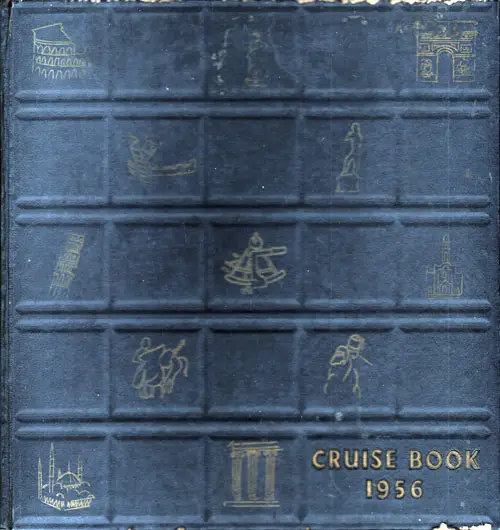
Front Cover, USS Coral Sea CVA 43 Cruise Book - 1956 Mediterranean Cruise. GGA Image ID # 19bcced427
Preface
Too often the oct of creation brings with it its own disenchantment. In making this book for you it was very easy at times to be cynical, or casual about what we had seen, or whet our knows had experienced.
However, a moment's contemplation still would serve to bring bock the wonder at the fascinating process whereby a group of novices unfamiliar with the intricacies of carrier life ore molded into the complicated pattern which is today's naval aviation.
Visiting lands whose very names create a magic of their own was sufficient to rekindle our excitement. Perhaps a little shoddy now, and poorly used by her admirers, the Mediterranean and her surrounding countries are the birthplace of western culture and philosophy — our heritage. With one sweep of this living tableau we can see the traces of the past, the face of today, and the promise of the future.
To not understand what we have been privileged to see would be unfortunate, but to ignore it would be o tragedy.
Let us join together, then, and revisit the peoples, events, and places which marked our lost year together.
Editor-in-Chief
Schedule of Coral Sea Cruse 1956-57
1956
- Prior to 1 February: at Norfolk Naval Shipyard, Portsmouth
- 1 February: Left NNSY; at Norfolk Naval Base
- 14 February: Enroute Mayport, Florida for underway shakedown training
- 28 February: Depart Mayport Operating area, enroute Guantanamo Bay
- 1-5 March: GTMO Operating Area
- 7-23 March: More shakedown training off Mayport
- 27-31 March: GTMO, Fleet Training Group aboard for Battle Problems
- 2 April: Ship's Operational Readiness Inspection
- 5 April: Norfolk
- 9-13 April: Operation Intex
- 23 April: Depart Norfolk for New York
- 27-30 April: Weekend in New York, Pier 86
- 1 May: Return to Norfolk
- 3 May: Joint Civilian Orientation Cruise
- 8 May: Entered NNSY for major repairs to reduction gears
- June: NNSY
- 2 July: Depart Portsmouth, at Norfolk Naval Base
- 3-20 July: Operations in Norfolk area
- 24-31 July: Carrier Pilot Qualifications off Mayport
- 1-12 August: Mayport Operating Area
- 13 August: Underway for the Mediterranean
- 23 August: Passed through the Straits of Gibraltar
- 26 August: Arrive Golfo de Palmas, relieve the USS INTREPID
- 28 August — 5 September: Naples
- 5-14 September: At Sea
- 14 September: Naples
- 15-24 September: Palermo, Sicily
- 25-30 September: Operation Whipsaw
- 2-8 October: Genoa
- 10 October: Captain Joseph A. Jaap relieves Captain William E. Gentner, Jr.
- 15-20 October: Athens, Greece
- 20 October: Visit of King and Queen of Greece
- 24-27 October: Istanbul, Turkey
- 31 October: Arrive vicinity of Alexandria, Egypt
- 1 23 November: Suez crisis, Points Abraham, Isaac, Jacob and Moses.
- 23 26 November: Augusta Bay, Sicily
- 26 November-7 December: At sea, Point Jericho
- 7-11 December: Taranto, Italy
- 20-27 December: Cannes
- 27-28 December: at sea
- 28 December-1 January 1957: Cannes
1957
- 2-11 January: At sea, fleet exercises
- 11-21 January: Naples
- 2-4 February: Gibraltar. Relieved by the USS FORRESTAL
- 4-12 February: Enroute to Conus
Shakedown
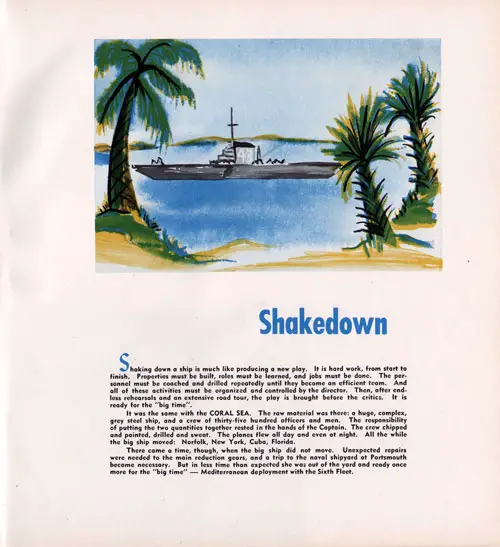
Shakedown - USS Coral Sea CVA 43 1956 Deployment to the Mediterranean. GGA Image ID # 19bcff8173
Shaking down a ship is much like producing a new play. It is hard work; from start to finish. Properties must be built, roles must be learned, and jobs must be done.
The personnel must be coached and drilled repeatedly until they become an efficient team. And all of these activities must be organized and controlled by the director.
Then, after endless rehearsals and an extensive road tour, the play is brought before the critics. It is ready for the "big time".
It was the same with the CORAL SEA. The raw material was there: a huge, complex, grey steel ship, and a crew of thirty-five hundred officers and men.
The responsibility of putting the two quantities together rested in the hands of the Captain.
The crew chipped and painted, drilled and sweat. The planes flew all day and even at night. All the while the big ship moved: Norfolk, New York, Cuba, Florida.
There came a time, though, when the big ship did not move. Unexpected repairs were needed to the main reduction gears, and a trip to the naval shipyard at Portsmouth became necessary.
But in less time than expected she was out of the yard and ready once more for the "big time" — Mediterranean deployment with the Sixth Fleet.
Tours
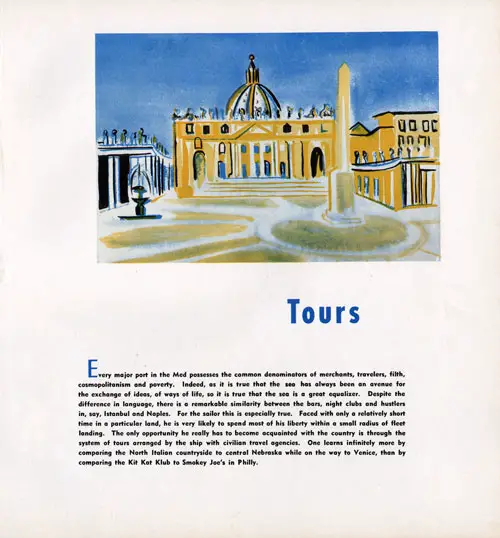
Tours of Major Ports in the Mediterranean by the USS Coral Sea CVA 43 in 1956. GGA Image ID # 19bd44f52d
Every major port in the Med possesses the common denominators of merchants, travelers, filth, cosmopolitanism and poverty. Indeed, as it is true that the sea has always been an avenue for the exchange of ideas, of ways of life, so it is true that the sea is a great equalizer.
Despite the difference in language, there is a remarkable similarity between the bars, night clubs and hustlers in, say, Istanbul and Naples. For the sailor this is especially true.
Faced with only a relatively short time in a particular land, he is very likely to spend most of his liberty within a small radius of fleet landing.
The only opportunity he really has to become acquainted with the country is through the system of tours arranged by the ship with civilian travel agencies.
One learns infinitely more by comparing the North Italian countryside to central Nebraska while on the way to Venice, than by comparing the Kit Kat Klub to Smokey Joe's in Philly.
Recreation
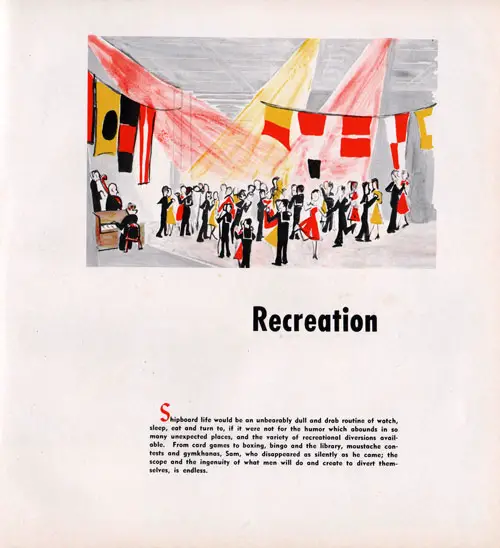
Recreation on or off the Ship, Improving the Life of Sailors Aboard the USS Coral Sea during the 1956 Mediterranean Cruise. GGA Image ID # 19bd4b4207
Shipboard life would be an unbearably dull and drab routine of watch, sleep, eat and turn to, if it were not for the humor which abounds in so many unexpected places, and the variety of recreational diversions available.
From card games to boxing, bingo and the library, moustache contests and gymkhanas, Sam, who disappeared as silently as he came; the scope and the ingenuity of what men, will do and create to divert themselves, is endless.
Ports
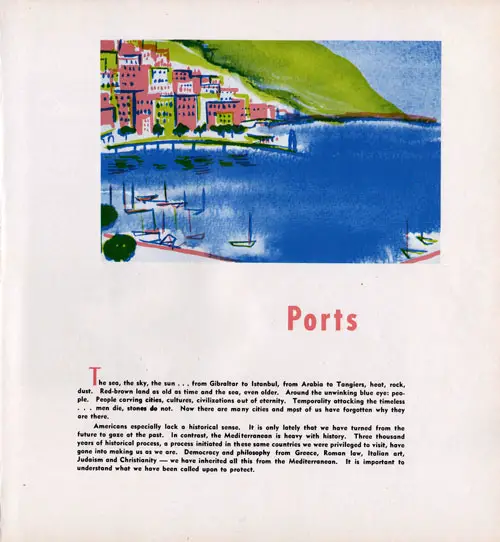
Mediterranean Ports and Their Importance. USS Coral Sea CVA 43 Mediterranean Cruise Book of 1956. GGA Image ID # 19bd80af32
The sea, the sky, the sun ... from Gibraltar to Istanbul, from Arabia to Tangiers, heat, rock, dust. Red-brown land as old as time and the sea, even older. Around the unwinking blue eyed people.
People carving cities, cultures, civilizations out of eternity. Temporality attacking the timeless men die, stones do not. Now there are many cities and most of us have forgotten why they are there.
Americans especially lack a historical sense. It is only lately that we have turned from the future to gaze at the past. In contrast, the Mediterranean is heavy with history.
Three thousand years of historical process, a process initiated in these same countries we were privileged to visit, have gone into making us as we are.
Democracy and philosophy from Greece, Roman law, Italian art, Judaism and Christianity — we have inherited all this from the Mediterranean. It is important to understand what we have been called upon to protect.
Summary
In May of 1942 a battle was fought that marked a turning point in the history of naval warfare. For the first time a major naval engagement was fought in which no ship from either side sighted the other, nor was a single salvo exchanged between surface vessels.
This was the Battle of the Coral Sea, a landmark in the Pacific war and a classic affirmation of the importance of naval aviation as an indispensable weapon of modern warfare.
In commemoration of this memorable battle the USS CORAL. SEA (CVA 43), the third and last of the great Midway Class, was commissioned on 1 October 1947.
Since that date, the CORAL SEA has spent the vast majority of her time at sea. Forming a vital part of the atlantic and Sixth Fleet she has become a familiar sight in the various ports of the Mediterranean.
Her primary peace time missions are that of training and good will. In both of these endeavors she has been singularly successful.
The big carrier has been home to a succession of skippers, officers and over ten thousand men thus far in her career. Yearly cruises of six and seven months are commonplace.
The size of the CORAL SEA is of continual amazement to those who live aboard her. She is a statistician's dream. Almost four million meals are served aboard each year. If stood on end she would be only 150 feet shorter than the Empire State Building.
Capable of staying at sea for months at a time, the ship provides every necessity and many luxuries from laundries to newspapers, haircuts to ship's band, foreign goods store to radio station; the list is inexhaustible.
Currently scheduled for conversion to an angled deck carrier with steam catapults, the CORAL SEA will enter th Naval Shipyard, Bremerton, Washington in the Spring of 1957.
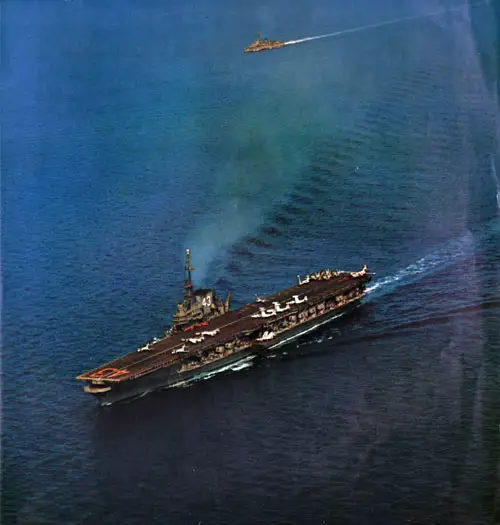
The USS Coral Sea CVA 43 Aircraft Carrier Cruising at Sea, 1956. GGA Image ID # 19bd9b8926
